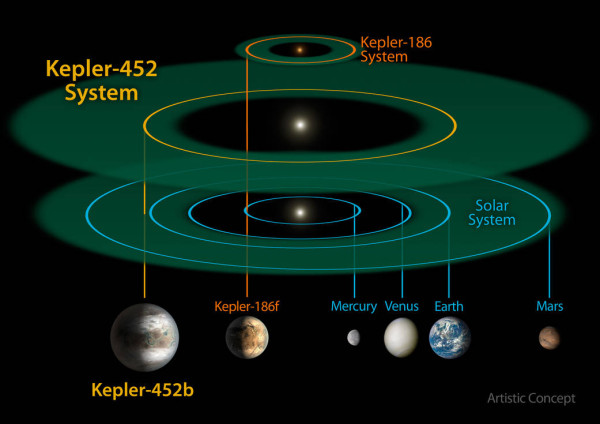“You can spend too much time wondering which of identical twins is the more alike.” -Robert Brault
Earlier today, NASA announced the "most Earth-like exoplanet yet," a planet just 60% larger in radius than our own, orbiting a star of the same spectral class as our Sun and with an almost identical orbital period: 385 days.
But is this really the most Earth-like planet we've discovered? It's significantly larger and five times as massive, and may actually be more like Neptune than like Earth. In fact, other properties may be much more important if we truly want to find a "twin" to Earth: a rocky planet teeming with advanced chemical-based life.
What do we have versus what did we find? Come discover it all on today's Throwback Thursday!



Is earth’s twin out there?
Heck, the earth probably has BILLIONS of twins (and so do you), in that bit of fiction, that curious time and space which we call…
The Twilight Zone
(a.k.a. the “multiverse.”).
On Space.com in quick 1 minutes, 16 second video they put together for the announcement, they have a graph in the middle of the video showing the shifting habitable zone of a star over time.
Just before the star goes into the red giant phase and burns up the planets, the graph shows the stars spend half a billion years cooling slightly. What is happening there? What is it that creates a pause in the otherwise inexorable rise in temperature over a star's lifetime?
No, see fuck all, the twilight zone is a work of fiction. Rather like Christianity.
The Multiverse is a consequence of known science. Not fiction.
Then again you think that fiction is reality, so why is anyone surprised you think the twilight zone is reality...
Denier, there is no inexorable rise without a pause even BEFORE that event.
The change in the habitable zone is not due to a change in temperature of the star. Just its surface luminosity. Which depends on the size and temperature of the star.
And when a star goes from yellow dwarf to red giant, the colour change indicates the temperature is falling.
The result of that is complicated, but can result in either a reduction in the solar constant or an increase of it, depending on what's going on specifically with that size and composition of star.
"The Multiverse is a consequence of known science"
Got any observable proof?
If not then your know science is a "post-empirical" load of bollocks.
http://www.npr.org/sections/13.7/2015/01/27/381809832/the-most-dangerou…
"Got any observable proof?"
Yes, known science is the result of observed phenomena, retard.
Hey, raggie, ever seen the inside of a brick?
No?
Then your belief that there is an interior to that brick is "post-empirical bollocks".
Ever seen Thomas Jefferson? No? Then your belief that one of the founding fathers existed is "post-empirical bollocks".
How many false set ups can I do now you've done one?
Re. Ragtag Media @ 5:
Having read your linked article, what I see looks a lot like political partisans ginning up a controversy when they should be cooperating.
The reason string theory and multiverse theory exist in the first place is that they are logical outgrowths of attempts to reconcile problems in our existing theories. The fact that they are both untestable _at present_ does not mean that either or both of them will never generate a testable prediction. The only way to find out is to keep going and see where they get us.
I don't see physics or cosmology turning into postmodernist mush there. Empiricism is not dead nor even injured: it's still the gold standard and, if nothing else, produces too many useful results to be abandoned. So in both a principled way and a pragmatic way, it will remain.
The solution to the real debate over theory today, is to increase funding, hiring, research, and teaching accordingly. As for where to get the money, various progressive taxes will do nicely, and any sane Republican should also agree that if Nixon was a good conservative, then the Nixon-era tax rates are acceptable. That will buy us all the scientists, professors, labs, space telescopes, and scholarships from undergrad to post-doctoral fellowships, that we need. (On a different issue entirely, that kind of revenue will also buy us the replacement of fossil fuel energy sources with climate-clean power, which will buy us time to deal with the underlying factors in ecological overshoot, and prepare the way forward toward a very real renaissance.)
People coming up through these fields also need to be educated in the psychology of science, which is to say, they need to learn and recognize and internalize the point that they should not become so emotionally committed to any given theory as to compromise their objectivity or put them at risk of existential crisis should their preferred theory be falsified or superseded. Some of these theories are going to be knocked out of the running, and the people who are committed to them should be able to accept that situation with grace and then turn their attention to new problems.
We could be on the verge of climate catastrophe, and we could also be on the verge of a scientific renaissance that enables us to look even further into the fundamental questions of existence. This is one of those historic times when both the existence of civilization itself, and the highest aspirations of humanity, are both in play. There is no room for apathy or laziness in the face of such potential.
Re. Ethan's article:
If I understand you correctly:
= Reasonable calculations lead to the conclusion that star systems & planets that duplicate the Sun & Earth scenario, are relatively few in number.
= The enormous number of M-class red dwarfs offers a potentially highly fruitful set of places to look for planets that might harbor intelligent life.
OK, that makes sense. From previous articles, I also get that it is going to take a substantial improvement in our technology, to be able to resolve objects of the relevant sizes.
Now heading off into wild speculation territory: Re. what you said about planets in the habitable zone of M-class red dwarfs being exposed to solar flares and the like: How would an intelligent civilization protect a planet's ecosystems & habitability from any such events?
I'm still convinced that the convergent solution for intelligent life is to aim for interstellar civilization based on "rogue" (free-floating) planets and Dyson rings around suitable stars as remote energy sources: a network of these types of objects adds up to something highly resilient and robust.
And I'm also thinking that NASA is going to surprise us with an announcement about signs of rudimentary life, sooner than we expect. Perhaps soon enough to bear on next year's election. One can hope, anyway.
BTW, can we do something about cleaning up the comments around here?, they've been getting downright repellant but I've decided to not let it deter me. Others may not have such a large supply of barf bags at hand. Better to make good use of the broom and shovel.
"How would an intelligent civilization protect a planet’s ecosystems & habitability from any such events?"
The problem really isn't the actions of intelligent life but the problem of getting TO intelligent life that is advanced enough to do something to stop them dying when the sun flares up.
The problems of flares and so on are much like we get here with CME's (read up on them), but worse.
Hardening against EM damage, non reliance on kit affected, or just burying yourself under the crust and wait it out are all options. If you're landing there from some other planet.